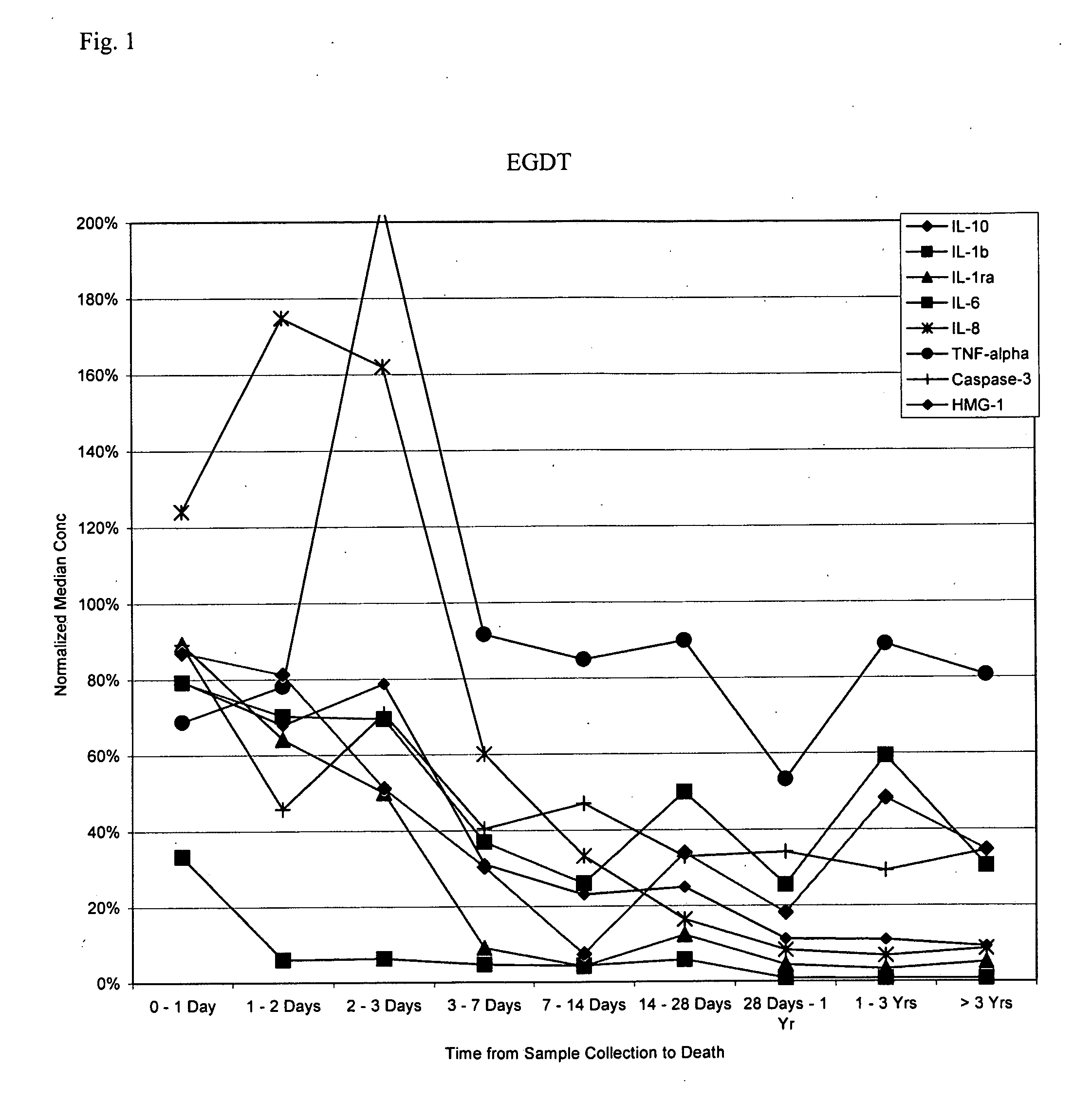Methods and compositions for determining treatment regimens in systemic inflammatory response syndromes
a systemic inflammatory response and syndrome technology, applied in the field of systemic inflammatory response syndrome treatment regimens, can solve the problems of not being able to confirm 50% or more of patients exhibiting strong clinical evidence of sepsis, no diagnostic tools have been described to unambiguously distinguish sepsis related conditions, etc., and achieve the effect of increasing the discriminating power of marker panels
- Summary
- Abstract
- Description
- Claims
- Application Information
AI Technical Summary
Benefits of technology
Problems solved by technology
Method used
Image
Examples
example 1
Subject Population
[0261] The subjects in the following examples are a subset of those reported in Rivers et al., N. Engl. J. Med. 345: 1368-77, 2001, which is hereby incorporated in its entirety. Samples were obtained at admission, and the subjects were then subdivided into two random groups, one of which received standard sepsis therapies, the other of which received an early goal-directed therapy (“EGDT”) regimen devised by the authors. In general, blood specimens are collected by trained study personnel using EDTA as the anticoagulant and centrifuged for greater than or equal to 10 minutes. The plasma component is transferred into a sterile cryovial and frozen at −20° C. or colder. Clinical histories are available for each of the patients to aid in the statistical analysis of the assay data.
example 2
Biochemical Analyses
[0262] Markers are measured using standard immunoassay techniques. These techniques involved the use of antibodies to specifically bind the protein targets. A monoclonal antibody directed against a selected marker is biotinylated using N-hydroxysuccinimide biotin (NHS-biotin) at a ratio of about 5 NHS-biotin moieties per antibody. The antibody-biotin conjugate is then added to wells of a standard avidin 384 well microtiter plate, and antibody conjugate not bound to the plate is removed. This forms the “anti-marker” in the microtiter plate. Another monoclonal antibody directed against the same marker is conjugated to alkaline phosphatase using succinimidyl 4-[N-maleimidomethyl]-cyclohexane-1-carboxylate (SMCC) and N-succinimidyl 3-[2-pyridyldithio]propionate (SPDP) (Pierce, Rockford, Ill.).
[0263] Immunoassays are performed on a TECAN Genesis RSP 200 / 8 Workstation. Biotinylated antibodies are pipetted into microtiter plate wells previously coated with avidin and ...
example 3
Marker Panels for Assignment of Therapy in SIRS
[0265] Using the methods described in PCT application no. US03 / 41426, filed Dec. 23, 2003, exemplary panels for risk stratification is SIRS were identified. Starting with a large number of potential markers, an iterative procedure was applied. In this procedure, individual threshold concentrations for the markers are not used as cutoffs per se, but are used as values to which the assay values for each patient are compared and normalized. Rather, a “window” of assay values between a minimum and maximum marker concentration (calculated as midpoint±midpoint×linear range in the tables below) is determined. Measured marker concentrations above the maximum are assigned a value of 1 and measured marker concentrations below the minimum are assigned a value of 0; measured marker concentrations within the window are linearly interpolated to a value of between 0 and 1. The value is then multiplied by a weighting factor (weight average in the tabl...
PUM
| Property | Measurement | Unit |
|---|---|---|
| Fraction | aaaaa | aaaaa |
| Fraction | aaaaa | aaaaa |
| Current | aaaaa | aaaaa |
Abstract
Description
Claims
Application Information
 Login to View More
Login to View More - R&D
- Intellectual Property
- Life Sciences
- Materials
- Tech Scout
- Unparalleled Data Quality
- Higher Quality Content
- 60% Fewer Hallucinations
Browse by: Latest US Patents, China's latest patents, Technical Efficacy Thesaurus, Application Domain, Technology Topic, Popular Technical Reports.
© 2025 PatSnap. All rights reserved.Legal|Privacy policy|Modern Slavery Act Transparency Statement|Sitemap|About US| Contact US: help@patsnap.com


